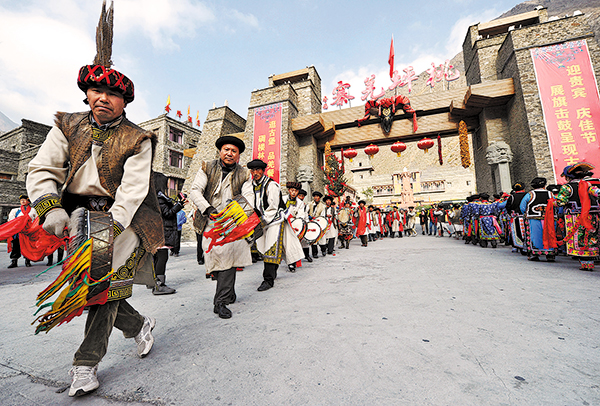Tourism revives millennia-old Qiang village
From:China DailyAuthor: 2024-01-16 14:38

Ethnic Qiang people dance to greet the new year according to their traditional calendar in Taoping Qiang village, Aba Tibetan and Qiang autonomous prefecture, Sichuan province.[Photo by He Haiyang/For China Daily]
Nestled in a gorge near the upper reaches of the Minjiang River in Southwest China's Sichuan province, Taoping Qiang village has existed for over two millennia.
Originally constructed for military defense, the village's watchtower has seen the flames of war extinguished over the ages and is now a tourist attraction. Surviving the devastating 2008 Wenchuan earthquake, the tower still stands tall and now bears witness to the area's transformation.
The village was reconstructed in the aftermath, and a new village in the same architectural style was built nearby, with many residents choosing to move there for a better quality of life. Today, visitors are drawn to the picturesque village, bringing prosperity to the local tourism industry.
By Dec 25, the Taoping village area had welcomed 189,000 tourists in 2023, driving sales of local farm products to 30.8 million yuan ($4.35 million) and generating over 95.2 million yuan in tourism revenue.
The skyrocketing sector has brought new opportunities and tangible benefits to locals, such as Maixi, who is a member of the Qiang ethnic group. Her journey has mirrored the remarkable development of her hometown.
Maixi, one of eight children, worked as a shepherd when she was a girl. Now 60, she has achieved prosperity by converting her ancestral home into a homestay business.
And she has expanded her hospitality venture by opening a four-story homestay in the new village, drawing in a steady stream of repeat customers, who enjoy her signature dish of a hearty soup with cornmeal and pickled vegetables.

The village's traditional-style architecture.[Photo by Xu Jun/For China Daily]
She is not shy about saying she now leads a life that seemed unattainable in her youth. The income her family brought in by selling Sichuan peppers was essential during her childhood, she remembers, and the children would work alongside the adults all day long throughout the harvest season as sun-dried peppers fetched a high price.
"With over 440 households and a population of more than 1,300, the village no longer relies on herding. Half of our workforce is now involved in tourism, and we also cultivate over 1,000 mu (67 hectares) of cherries and various other fruits. In recent years, the average income per mu has been about 60,000 yuan," says Yang Buyi, Party chief of Taoping.
People of the Qiang ethnic group have not only witnessed the post-quake reconstruction of their hometown and watched it transform into a thriving tourist destination, but also experienced the resurgence and flourishing of the Qiang culture.
"My family has lived here for generations, so I am delighted to witness the prosperity of the village and the continuation of the Qiang culture," says Wang Jiajun, standing amid a crowd of visitors in the folk culture museum he established.
Wang, who is over 80 years old, spent more than 20 years collecting over 1,000 Qiang artifacts for the museum, where they are displayed today.
"Look at these three sets of local artifacts — cauldrons crafted from clay, copper and iron. Despite the passage of over 1,000 years, their forms remain unchanged," Wang says. "This is a symbol of cultural inheritance, and I hope that our excellent traditional culture will continue to be passed down."
Edit:董丽娜
The copyright of the article and the picture belongs to the original author. If there is any infringement, please contact to delete it